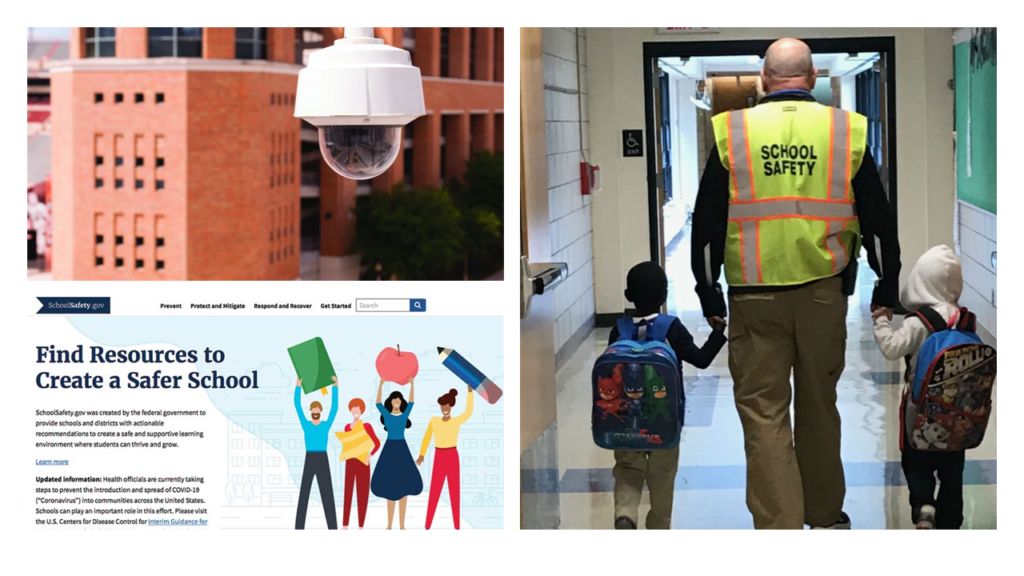
In the wake of the Uvalde school shooting, security remains the primary concern for schools as the new academic year begins, but maintaining strong physical security systems requires resources in the form of training, technology, and support. While there is no one-size-fits-all approach to school security, resources are available throughout the country to strengthen school security in preparation for a safe school year.
With so much federal and state funding directed at improving school safety, school districts have a unique opportunity to update current security measures and address long-term systematic issues. Thus, the strategy for investing becomes twofold:
- Identifying and mitigating the school district’s security vulnerabilities.
- Implementing and streamlining security systems that address current security challenges and anticipate future needs.
In this article, we’ll share helpful school security resources for local education agencies to maximize funding and a collection of tips and insights to help schools strengthen their physical security posture.
K-12 School Security Risk Assessment
Before applying for a grant or even searching for resources, schools should have a security planning team or something equivalent in place. The team should include engaged staff members and community leaders with diverse backgrounds. The purpose of this group is to aid school leaders in commissioning and reviewing site-specific assessments and developing actionable security plans.
In addition to internal meetings, the school’s security team should meet regularly with their public safety partners, including first responders and emergency management agencies, to discuss contingencies and response coordination. The security planning team can review helpful data, including risk assessments, local crime and safety reports, and any relevant information to help gauge their risk profile.
All of this data eventually leads to school security assessment. School security assessments should be district-specific and based on quantitative analysis of the type of threats a school faces. The Cybersecurity and Infrastructure Security Agency (CISA) provides schools with a web-based K-12 School Security Assessment Tool (SSAT) to help schools define and approach their physical security needs.
School resource spotlight #1: K-12 School Security Assessment Tool (SSAT) The tool will ask questions about your school’s attributes such as grade levels served, location, campus layout, and the presence of school security personnel.
K-12 School Security Funding
In addition to the challenges of evaluating a school’s security posture, schools often face constraints when it comes to funding security improvements. Even if schools get funding, many districts have limited maintenance, repair, and replacement budgets. On top of that, school boards must proactively balance security measures while addressing a wide range of parental concerns.
Schools receive funding from various sources including state and federal programs, local property taxes, and grants. However, all funds have a specific purpose, and school districts treat federal funds separately for ease of monitoring and tracking federal dollars within complex district budgets. Under state law, school districts may spend the funds in two ways:
- Regular operating budget (also known as Maintenance and Operations (M&O) mainly used to fund employee salaries, benefits, and classroom supplies.
- Capital funds used to build and equip schools, repair and upgrade existing buildings, buy school buses, and purchase technology.
Several states encourage or even require district use of awarded funds to prioritize school safety enhancements, including student safety and effective use of technology within the larger framework of school and district emergency preparedness.
School resource spotlight #2: SchoolSafety.gov’s Grants Finder Tool helps you find applicable funding opportunities to help keep your school community safe. The tool features a variety of Federally available school safety-specific grants that you can navigate based on a school safety topic, award amount, application level of effort, and more.
K-12 School Security Regulations
The number of regulations and their continuous changes makes it challenging for school leaders to keep up. Additionally, the school board may place further constraints on selecting and implementing specific physical security measures at the local level. Not to mention, district mandates might require that local education agencies consult legal counsel and insurers before implementing special measures in the first place.
Ultimately, the regulations that govern school physical security are mainly enacted at the state level, and there are wide variations in state mandates and guidelines. For this reason, states commonly develop guidance specific to these statutes and regulations, and many also outline best practices related to physical security.
School resource spotlight #3: Education Commission of the States researched K-12 school safety policies in all 50 states and the District of Columbia to provide this comprehensive resource.
States provide school security resources
Post Uvalde, school safety funds are coming from both the federal and state levers of government. For example, the New Hampshire Department of Safety’s Division of Homeland Security and Emergency Management made over $13 million available to New Hampshire schools under the effort named the Security Action for Education program, or SAFE.
The Safe Schools Act enables school districts to use unused COVID relief dollars allocated to schools through the Elementary and Secondary School Emergency Relief (ESSER) Fund for schools to improve safety and security. In addition to the Safe Schools Act and ESSER program, schools can inquire about additional funding opportunities through:
- FEMA Grants: Available for pre and post-emergency or disaster-related projects. These funds support critical recovery initiatives and many other programs.
- Homeland Security Grant Program: This grant provides recipients with the resources required for the implementation of the National Preparedness System and working toward the National Preparedness Goal of a secure and resilient nation.
Schools can use these funds to enhance their physical security measures, such as locks, panic buttons, physical security systems, video surveillance, and human resources. Strategically planning for the use of funds and taking advantage of these unique opportunities are essential for school leaders.
School resource spotlight #4: Budget planning with ESSER Funds-An overview on how LEAs can use ESSER funds to minimize any negative fiscal disruption and maximize value.
Texas schools security
Schools in Texas will approach the 2022–2023 school year more proactively in light of the tragedy. Senate Bill 500, appropriated $100,000,000 to Texas Education Agency (TEA) for enhanced security measures to be implemented in public schools. Some of these measures include metal detectors at school entrances and bullet-proof glass or film for school entrances.
Texas school districts are required to comply with the following new safety standards:
- Conduct a Summer Targeted Partial Safety Audit
- Conduct an Exterior Door Safety Audit
- Ensure all campus staff (including substitutes) are trained on their specific LEA and campus safety procedures
- Schedule all mandatory drills for the school year
- Ensure all threat assessment team members are trained
- Review and, if necessary, update access control procedures (For the new school year, access control procedures must include exterior door sweeps (ensuring doors are closed and locked) at every instructional facility at least once each week while instruction is being conducted.
- Convene the LEA’s Safety and Security Committee to review: the multi-hazard emergency operations plan (EOP) and, as a component of the EOP, the LEA’s active threat plan
School resource spotlight #5: The Texas Education Agency (TEA) extended the end date for the 2019-2021 School Safety and Security Grant Notice of Grant Award (NOGA). The new end grant end date is June 15, 2023. Grantees do not have to amend their applications to receive their revised NOGA.
Resources for Families
The main approach organizations are using when it comes to providing mental health support for families is an evidence-based intervention developed by the National Child Traumatic Stress Network (NCTSN). It aims to ascertain child and family needs and provide immediate practical assistance, support, and resources in the wake of disasters.
Most importantly, the National Child Traumatic Stress Network has developed resources to help children, families, educators, and communities navigate what they are seeing and hearing, acknowledge their feelings, and find ways to cope together. Additional resources include:
- Texas Children’s Health Plan
- American School Counselor Association
- American Psychological Association
Proactive school security
School districts can implement many practical steps and cost-effective frameworks to adopt a proactive school security posture. However, whereas some schools with low-risk profiles may have adequate security measures, schools with recurring crime and related needs usually lack the desired security measures to foster a safe learning environment.
At a minimum, school districts should invest in new or at least updated technology, perimeter security, visitor management, or other physical aspects of security to make sure the basics are working correctly and providing helpful support.
The bottom line is that school leaders need to think about how the protection and mitigation options they have in place affect the broader school mission, operations, and climate. Unfortunately, this task can be overwhelming for school district professionals already stretched with academic and safety issues.
The good news is that school leaders don’t need to solve their district’s security challenges alone. Partnerships with security integrators are an essential tactic for putting school safety funds to good use. At 3Sixty Integrated, we’ve developed a robust framework to help school districts design, install, and manage their physical security systems. Visit our website to learn more about our approach or call us at (210) 545-1770.

